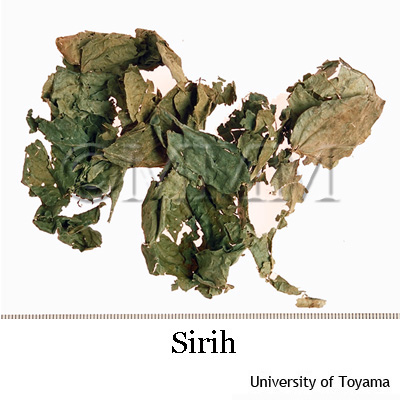Crude drug sample data base
※Click on the image to enlarge it.
Scientific information data base
| Crude drug name | Indonesian name, English name | Daun sirih, Betel pepper | ||||
|---|---|---|---|---|---|---|
| Synonyms | Daun suruh | |||||
| crude drug image |
| |||||
| Original plant name | Piper betle Linn. | |||||
| Family name | Piperaceae | |||||
| Used part | Leaves | |||||
| Distribution area | It occurs throughout Indonesia; in Java (Indonesia) it grows from 200 up to 1000 m altitude. It is planted in home gardens [201]. | |||||
| Description | Leaves alternate, ovate, apex acute, base cordate, margins intact, emits fragrance when crushed. It tastes pungent, hot and spicy. The plant is evergreen climbing vine and perennial. It may climb as high as 10-15 feet and is usually supported by bamboo poles; stems contain large nodes which send out roots. Flower unisexual, spike, inflorescences axillary. Fruit ovate. The common Piper betle Linn. is locally called sirih Jawa (Javanese betel). Another cultivars are: Sirih banda (Banda betel): leaves are wide, blackish-green in color and was cultivated in some islands including Banda, Seram, and other islands in the south and east parts. Sirih cengke (cengke betel): leaves are narrower, yellow in color, has a sharp taste similar to clove. Sirih hitam (black betel): it is cultivated for its medicinal properties. Siriboa: the plant is bigger than sirih Jawa. Young leaves are used as an alternative for sirih Jawa leaves. The fruit is used for medicinal purpose, and there are 3 varieties : 1. White siriboa (siriboa putih): it has mild taste similar to spices and gives a pleasant odour to the mouth and thus is the most variety often used. 2. Goat siriboa (siriboa kambing): it has stronger taste and also gives a pleasant odour to the mouth. 3. Kulilawan siriboa: it has the strongest taste and aroma of all. | |||||
| Drug effect | Pungent, warming, blood cleanser [231]. | |||||
| Specific actions | Astringent, expectorant, antiseptic [231]. | |||||
| Frequency in use | Abundant. | |||||
| Pharmacological effect | The aqueous components of inflorescence Piper betle are potential reactive oxygen species scavengers and may prevent the platelet aggregation possibly via scavenging reactive oxygen species or inhibition of thrombin-induced thromboxane B[2] production [PMID:12643677]. From an evaluation of the effect of P. betle on glucose metabolism, it was shown that P. betle intake influences glucose metabolism beneficially [PMID:16579737]. Hot water extract and cold ethanolic extract of Piper betle leaves possess safe and strong antidiabetic activity [PMID:16055288]. | |||||
| Medical system | Indonesian medicine (Jamu) | |||||
| Traditional usage | In some parts of Java Island (Indonesia) the leaves are commonly chewed together with mineral lime (calcium oxide) and areca nut. The areca nut contains the alkaloid arecoline which promotes salivation and the saliva is stained red. Chewing the leaves together with lime and areca nut is believed to be effective as a stimulant of the central nervous system and digestive tract. In Sumatera (Indonesia), Batak people chew the leaves against halitosis (bad breath). Leaves are commonly used to treat tooth-ache, swollen gums, and clean wounds. It stops bleedings that occurs after having a tooth extracted. Tooth-ache is treated by chewing the leaves. Decoction of the leaves is applied for leucorrhea and hoarseness. To treat leucorrhea the decoction is used in sitz-bath. Decoction of a mixture of the leaves and sugar is a good remedy for cough and hoarseness. Crushed leaves are applied on the wounds while roasted leaves can be used to stop the overflow of milk in nursing mothers [201]. The essential oil content of the leaves has expectorant activity and thus betel leaves are considered a good remedy for cough [201]. | |||||
| Formulation | 1) Leucorrhea: 2 pieces of P. betle leaves and 5 pieces of Psidium guajava leaves are boiled with 210 ml of water. Use the decoction to wash the vaginal area twice a day [231]. 2) Hoarseness: 2 grams of P. betle leaves and 1 gram of cardamom fruits are boiled with 110 ml of water to make 100 ml of decoction. Drink the decoction once a day for 14 days [231]. | |||||
| References | Reference book Tips! | [201] K. Heyne, Tumbuhan Berguna Indonesia, Vols. 1-4, 1987. Diedarkan Oleh Koperasi Karyawan Departemen Kehutanan, Jakarta, Indonesia. Vol. 2, p 622. [222] P.T. Eisai Indonesia: Medical Herb Index in Indonesia (Second edition).1995. p 21. [231] Soedibyo, Mooryati: Alam Sumber Kesehatan: Manfaat dan Kegunaan (Natural resources for health. Benefits and uses). Balai Pustaka. 1998. pp 347-348. | ||||
| Research paper | 1. Santhakumari P, Prakasam A, Pugalendi KV. Antihyperglycemic activity of Piper betle leaf on streptozotocin-induced diabetic rats. J Med Food. 9(1):108-12, 2006. (PMID: 16579737) 2. Arambewela LS, Arawwawala LD, Ratnasooriya WD. Antidiabetic activities of aqueous and ethanolic extracts of Piper betle leaves in rats. J Ethnopharmacol. 14;102(2):239-45, 2005. (PMID: 16055288) 3. Lei D, Chan CP, Wang YJ, Wang TM, Lin BR, Huang CH, Lee JJ, Chen HM, Jeng JH, Chang MC. Antioxidative and antiplatelet effects of aqueous inflorescence Piper betle extract. J Agric Food Chem. 26;51(7):2083-8, 2003. (PMID: 12643677) | |||||
| Remarks | [DNA sequences] EF060062, EF060063, EF060064, EF060065, AJ554217 Betel leaves play an important role in Indonesian culture. It is used in traditional wedding ceremony of certain tribes and other ceremonies which are held regularly as part of the culture. | |||||
| Last renewal date | 2024/03/06 | |||||





